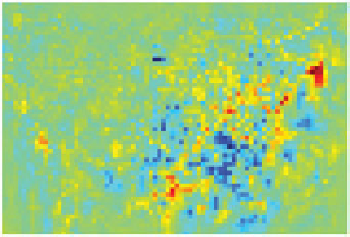Geoscience Reference
In-Depth Information
ogy. During a pollution episode, air is usually confined,
resulting in the buildup of concentrations over succes-
sive days. The major removal processes of pollutant
gases during and following an episode are chemical
reaction in the air, dissolution in falling raindrops or
ocean water, chemical reaction with the ground and
other surfaces, and transport (vertical and horizontal) to
the larger scale.
Organic gases emitted in polluted air ultimately break
down chemically to carbon dioxide and water. In the
case of aromatics and other heavy organics, the initial
breakdown steps are relatively fast. In the case of many
simpler, lighter organic gases, the initial breakdown
steps are often slow. Organic gases are also removed
by dissolution in rainwater and ocean surfaces, chem-
ical reaction with the ground, conversion to aerosol
particle constituents, and transport to the background
troposphere. Oxides of nitrogen often evolve chemi-
cally to nitric acid, which converts to particulate mat-
ter or deposits to the soil or surface water. Oxides of
nitrogen also react with organic gases to form organic
nitrate gases. Such gases decompose, convert to partic-
ulate matter, are rained out, or deposit to the ocean and
ground.
3
750
34.5
2
34
1
33.5
0
100
0
-1
33
-119
-118
-117
-116
(a)
4
45
2
40
0
35
-2
30
25
-4
-120
-100
-80
(b)
4.5. Summary
Urban air pollution has been a problem since the begin-
ning of civilization. Prior to the twentieth century, most
air pollution problems arose from the burning of wood,
coal, and other raw materials without emission con-
trols. Such burning resulted not only in smoky cities,
but also in health problems. In the early and mid-
twentieth century, severe London-type smog events
occurred during which emissions coupled with a fog
or a strong temperature inversion were responsible for
several fatal episodes. Increased use of the automobile
in the 1900s increased emissions of nitrogen oxides and
ROGs. In the presence of sunlight, these chemicals pro-
duce ozone, PAN, and a host of other products, giving
rise to photochemical smog. Smog initiates when ROGs
photolyze or are oxidized by OH(g), HO
2
(g), NO
3
(g),
O
3
(g), or O(g) to produce organic radicals. The rad-
icals convert NO(g) to NO
2
(g), which photolyzes to
O(g), which reacts with O
2
(g) to form O
3
(g). The most
important ROGs in urban air are aromatics, alkenes,
and aldehydes. Although alkanes are emitted in greater
abundance than the other organics, alkanes are less reac-
tive and longer lived than the others. Most organic gases
are destroyed in urban air, but long-lived organics, par-
ticularly methane, ethane, and propane, are transported
Figure 4.14.
Modeled difference in the August
24-hour average near-surface ozone mixing ratio in
(a) Los Angeles and (b) the United States when all
gasoline vehicles in 2020 are converted to E85
vehicles. The increase in population-weighted ozone
(population in a model grid cell multiplied by ozone in
the cell, summed over all cells, then divided by total
population) is
+
1.4 ppbv in the Los Angeles
simulation and
0.27 ppbv in the U.S. simulation.
From Jacobson (2007).
+
of the United States fall in the upper triangle of the iso-
pleths, where ozone increases due to E85. As such,
a conversion to E85 across the entire United States
increases the overall number of air pollution-related
deaths in Figure 4.14b by 4 percent (Jacobson, 2007).
Because gasoline and E85 both cause significant mor-
tality, neither is an ideal option. Instead, a conversion to
battery electric or hydrogen fuel cell vehicles, where the
raw energy originates from clean, renewable sources,
eliminates nearly all air pollution mortality from vehi-
cles (Chapter 13).
4.4. Pollutant Removal
Severe air pollution episodes generally last from a few
days to more than a week, depending on the meteorol-










Search WWH ::

Custom Search